![]()
![]()
![]()
Use LEFT and RIGHT arrow keys to navigate between flashcards;
Use UP and DOWN arrow keys to flip the card;
H to show hint;
A reads text to speech;
13 Cards in this Set
- Front
- Back
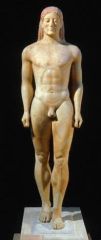
|
Kroisos, from Anavysos
(Anavysos Kouros), Marble, 530 BCE (6th century BCE) (Archaic)
Grave marker for Kroisos who died in a battle. Still adheres to the Egyptian style but we can see a more naturalistic approach in his proportions and more rounded modeling of face, torso and limbs. (archaic smile means he's dead) |
|
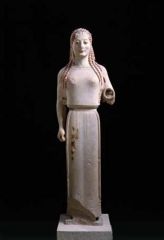
|
Peplos Kore
530 BCE (6th century BCE) Archaic Greek marble
kore = youthful female, clothed; peplos - garment, pleated at waist; some remnants of paint, brightly colored
•Found on the Athenian Acropolis. •Half life-size in height. •She wears a heavy woolen dress called a PEPLOS. •She was painted in bright colors. •Dedication to the goddess Athena •Wore a bronze wreath & earrings.
|
|
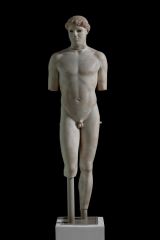
|
Kritios Boy
-Early Classical (Style); 480 BCE (5th century BCE) -First introduction of contrapposto -No archaic smile or orientalizing influences |
|
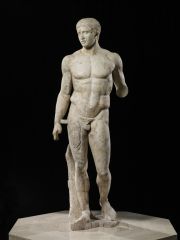
|
Spear Bearer (Doryphorus)
re-constructed marble
Early Classical, 450-440 BCE (5th century BCE)
-Artist: Polykleitos,
canon - idealized human proportions and beauty; perfect symmetry; contrapposto pose; original bronze melted down by Christians
-Would orignally have held a spear, demonstrating the might of the Athenian military
|
|
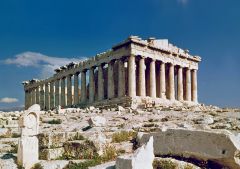
|
Parthenon
447-438 BCE (5th century BCE)
•First building Perikles commissioned. •Dedicated to patron goddess, Athena. •Doric temple. •Architects known: IKTINOS and KALLIKRATES. •Built partially on top of old temple ruins. •Made entirely of Pentellic marble. •Built to house the incredible ivory and gold cult statue of Athena, sculpted by PHEIDIAS (now lost). •He probabaly also desgined the pediment sculpture (“The Elgin Marbles”) as well as the sculptured metopes and inner frieze. |
|
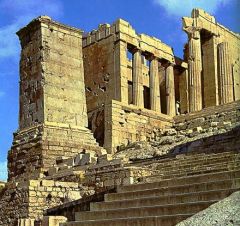
|
Propylai
437-432 BCE (5th century BCE)
High Classical
Acropolis (apart of)
1st museum
was to be used as a gateway to Acropolis sanctuary. -split level gateway with 6 columns front and back, five doored entranceway, Doric exterior and Ionic columns on the interior |
|
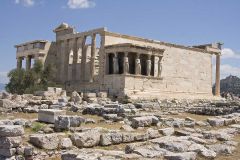
|
Erecheion
421-405 BCE (5th century BCE)
High Classical
•Ionic Temple. Built to replace the old Temple of Athena and to house the old cult image. Also of marble. •Half the size of the Parthenon and set away from Parthenon so not to compete. •Plan and elevation are UNIQUE too Greek architecture. •Porch projects from either side of the temple. All porches at different elevations, built around a ‘normal’ temple layout. Three doors lead into the central area. Windows in the temple covered with bronze lattices •Front of the temple stood 6 Ionic columns •South porch has statues of maidens (like we saw at the Treasury of Siphnos at Delphi) called KARYATIDS. •Besides representing the old temple to Athena and housing her cult image. • Also housed the altars of Erechtheus/Poseidon, Hephaistos andBoutes. •Erechtheus= in Greek mythology was the name of an archaic king of Athens, the re-founder of the polis (city-state) and in Athens he doubles for Poseidon, known as "Poseidon Erechtheus". •Boutes=the twin Brother of Erechtheus. He became the priest of the cult of Athena and Poseidion while his brother ruled Athens. •It also incorporated the tokens of the contest for the patronage of Athens, namely the salt-sea of Poseidon and the olive tree of Athena.
|
|
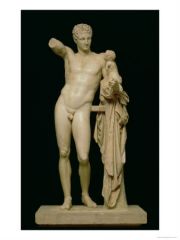
|
Hermes and the infant Dionysos
ca. 440 – 435 BCE
late Classical Greek
adjust canon, especially proportions; smaller head; shoulder at diagonal as well as hips; first to sculpt female nude
Location: Temple of Hera at Olympia
The god gazes dreamily into space while he dangles a bunch of grapes as temptation for the infant wine god.
|
|
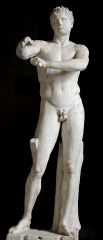
|
Apoxyomenos (Scraper)
Late Classical Style
Roman marble copy of a bronze original, ca. 330 BC.
Significance: introduction of new canon of proportions where bodies are more slender and head is smaller; possesses a nervous energy as he's about to shift his weight; right arm is extended, making the statue more 3D and encouraging viewers to see it from other angles
The Apoxyomenos motivated a departure from the style of Polykleitos, men as they were, and formed a transition to the active, psychological aspects of the sculpture of the Hellenistic Period.
The Apoxyomenos depicts an athlete who has just finished exercising and has cleaned himself off with olive oil.
He is scraping the excess oil from his outstretched arm with a curved metal scraper (strigil).
Lysippos makes the legs slender and longer, the head also smaller, whose ratio is not one seventh of Polykleitos but one eighth. All these result in a more delicate, taller figure.
The Apoxyomenos stands in a similar stance to the Doryphoros, with the weight resting naturalistically on one leg. But instead of the sectioned and closed forms of the Doryphoros’ body, Lysippos unifies the body of the Apoxyomenos by allowing the sections of the body to flow into one another.
An absence of hard lines and overemphasized musculature yields a more naturalistic image.
Increased naturalism is further achieved through the portrait-like face and the tousled hair.
Although this depicts the traditional subject of the nude athlete, Lysippos introduces two innovations.
First, he establishes a new rule of proportions that differs from the Polykleitan canon: the body of the athlete is slender with longer limbs, the torso is shorter, and the head is only a tenth of the height of the body (heads were an eighth of the height of the body in the Polykleitan system).
Second, this sculpture is truly three-dimensional. For example, the hands are positioned in such a way; the right arm extends directly out toward the viewer and protrudes daringly into the viewing plane. The audience cannot fully appreciate the work from the front, but must circle the piece, viewing it from several angles. This creates a physical interaction between viewer and image, which influenced the psychological aspects of Hellenistic sculpture.
He also broke down the dominance of his frontal view and encouraged viewing his statues from multiple angles.
|
|
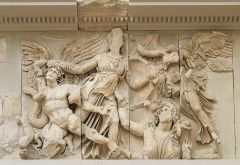
|
Athena battling Alkyoneos
Pergamon, c. 180BCE
frieze from Alter of Zeus Portrays 'Gigantomachy'. Athena is being crowned the victor by Nike. The women's faces are missing. Athena has her hand in the giants hair as he kneels symbolizing defeat |
|
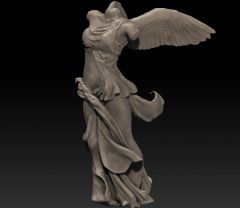
|
Nike of Samothrace, Hellenistic Greece
nike alighting on a warship, Greece,
ca 190 BC. Marble.
drama, movement, action; drapery, windblown effect
It was created to not only honor the goddess, Nike, but to honor a sea battle
It conveys a sense of action and triumph as well as portraying artful flowing drapery through its features which the Greeks considered ideal beauty
Victory has just landed on a prow to crown a victor at sea. Her wings will beat, and the wind seeps her drapery.
The placement of the statue, in a fountain of the splashing water, heighten the dramatic visual effect.
The work is notable for its convincing rendering of a pose where violent motion and sudden stillness meet, for its graceful balance and for the rendering of the figure's draped garments, depicted as if rippling in a strong sea breeze, which is considered especially compelling.
Nike of Samothrace is seen as an iconic depiction of triumphant spirit and of the divine momentarily coming face to face with man.
Nike suposedly, when she had her arms, was reaching to crown a victor. She seems to have all her weight on one leg, while he wings stretch out behind her. This seems much more naturalistic than the sculptures preceding it.
|
|

|
Laocoon and his sons
HELLENISTIC STYLE
-1 AD -Created by Rhodes scholars -Scene in the Aeneid -Was the pinnacle of expressionism, depicting great agony of Laocoon and his sons -Great influence on renaissance sculpture -Unusual that it is a sculptural group * Narrative: story of Trojan priest who warned fellow citizens * Apollo sent poisonous sea snakes to strangle Laocoon and his sons * expressive: shows figures' agony in expression and physical struggle * Admired and copied by Michaelangelo * his is from Rome, Italy and was made in early first century CE out of marble. You can see in this statue Laocoon is being attacked by sea serpants with his two sons on either side. |
|
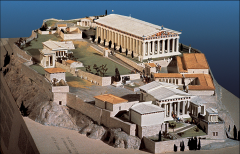
|
Model of the Acropolis Athens, Greece 1. Parthenon 2. Propylaia 3. Erechteheion 4. Temple of Athena Nike |

